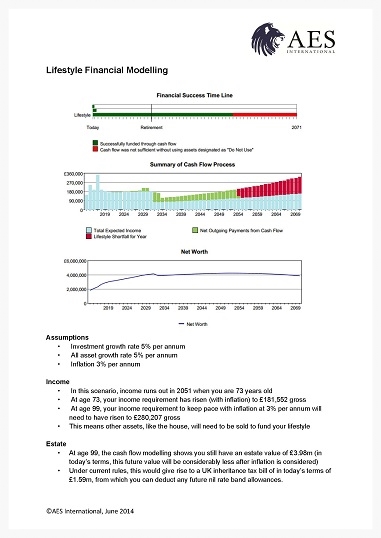

Expat saving for retirement - Part 2
Financial advisors often talk about saving for retirement in terms of investment risk. Whilst this is important and forms part of our advice on how expats should invest their money for retirement, here at AES International, we start by looking at risk differently.
“Life is full of risks and like it, or not, the financial adviser’s job is to minimise them. Risk is not the volatility of the investment markets, it is the failure to achieve our client’s objectives".
Free download: Expat Pensions: The Ultimate Guide »
The risk that you may not be able to retire at, for example, 60 years old, is a very real risk for many of our clients. Have I got enough? Is the question our clients ask us time and time again. In other cases, it is, I know I have enough, but what can I do to provide for my children and grandchildren? These are deeply important questions for many of us. Once we have established our client’s needs, we can complete the lifetime cash flow modelling, which gives us the investment rate of return you will need to grow your assets by each year in different scenarios to achieve your goals.

There are typically 4 outcomes after you have completed the financial modelling with your financial adviser.
Positive Outcome
-
You will be able to meet your goals if you stick to your budget and savings plan and take no investment risk.
Negative Outcome
-
You won’t be able to achieve your goals given your current budget and level of savings, so you will need to save more.
-
You won’t be able to save any more, therefore you will need to invest the savings you are making each month or year and this involves taking investment risk with your money.
-
You do not wish to take investment risk with your money and you cannot commit to saving any more. In this case, you will need to re-visit your plans and work through a more achievable set of goals.
You will now be in a good position to understand if committing to those goals is attainable and realistic. If you believe they are, you then need to commit to them with your financial planner, in order for you to reach them.
Once this is done, it’s time to talk about investment risk and your tolerance to it. Too little tolerance, or risk aversion, can prevent us from achieving some of our dreams, whether it be financial independence or early retirement. Too much tolerance to risk, or risk taking, can cause unpleasant financial surprises, which means we also miss our aspirations.
Free download: Expat Pensions: The Ultimate Guide »
All professional financial planners will ask a client to complete a personal financial risk profiling questionnaire. By answering a series of questions on risk and how you would view certain scenarios, the risk questionnaire provides the starting point to discuss risk in more detail and your tolerance to it with your advisor. The actual level of risk you need to take will be defined by your objectives and goals.
When it comes to investing, a professional advisor will rely not on his or own top fund picks of the day, but on a systematic and knowledge-driven approach to investments. An advisor should build you a personalised investment portfolio which balances the risks and rewards you have expressed in your risk profiling exercise with your individual goals that you have discussed in your lifetime cash flow modelling. The investment portfolio will typically be made up of equities, bonds and government debt, with some portfolios holding other assets like private equity, hedge funds and currency. This is known as your asset allocation, which is the optimum combination of investments needed in order to give you the potential to meet the goals you set with your advisor. However, if the proposed portfolio is too risky for your tolerance, you will need to revisit the 4 outcomes from your lifetime financial modelling and decide whether or not you are prepared to compromise on your goals, or take on more investment risk to achieve them.
Remember risk will change over time and if you are nearing retirement, you and your financial planner should monitor your investments at each review meeting and if necessary, start to reduce the investment risk you are taking in order to make sure you remain on track to meet your desired retirement date.
Free download: Expat Pensions: The Ultimate Guide »
Sometimes, your finances will be ahead of schedule and sometimes they may be behind, but most importantly, as a client you must commit to your goals, emotionally and financially. Make sure your financial advisor fully understands your goals and dreams and recommends a suitable investment portfolio, which should be reviewed regularly against the benchmarks that have been set. A good financial planner wants you to have the financial freedom that you will experience when you take the time to plan for you retirement and other life goals, and this initial planning can make a difference to whether or not you retire on time.
You can also read Retirement Planning for Expats, Part 1.
